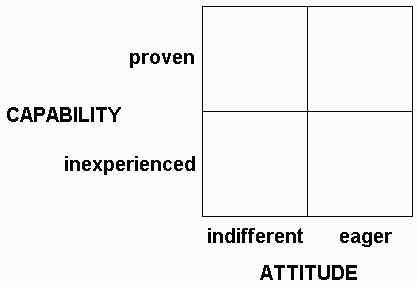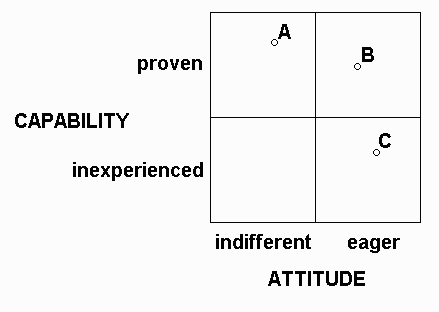
Existing service providers will have two significant characteristics:
- Experience in providing the services that you need.
- Compulsion to have you as a customer.

Figure 92.1: Capability and attitude matrix
Here, you can rate each service provider in the following terms.
- Do they have the capability to perform the services? You can rate them from "inexperienced" to "proven".
- Will you be a significant customer for them? You can rate them from "indifferent" to "eager."
Scanning the Market
This exercise need not be long and involved and certainly should not involve issuing tender documents.
List the Service Providers
First, you should obtain a list of the potential service providers.
You can do this
through a public announcement. In some circumstances, you may have to make a public announcement as part of ensuring
"contestability"; this can be true of government ministries, departments and agencies.
Alternatively, you may be
able to do it through trade advertising, through your contacts and networks, or through finding out which service providers are
used by organizations you admire.
Determine Their Capabilities
Second, you should determine the service providers' capability to provide the services that you seek. You can do this by talking to their existing customers.
Assess Their Attitude
Third, you should assess their attitude to you. You can base your estimate on how many other customers they have, how significant the revenues from you will be to them, and whether you will be a minor or a significant customer to them.
Examining the Relationship
You can now examine the relationship that you wish to have with your service provider.

Figure 92.2: Completed matrix
Proven, indifferent
Service provider A has great competence in providing the services. You will probably not be
a major customer to A.
This implies that there is unlikely to be a much opportunity for you to transfer assets and people to
A. It is probable that A will offer a standard service, based on its current infrastructure, without a need for additional staff. As a
result, you may have to consider your staff issues more closely when dealing with A. Even if you did not develop a closeness
with A, it could be an excellent choice to provide services that were "useful commodities" to your business.
Proven, eager
Service provider B is more likely to consider acquiring your staff and assets.
It is common
to find that the service providers to whom you will be a significant customer will have a lower capability than those like A. This
is not a problem, if you recognize that providers like B need customers like you in order to increase their capability and accept
that you may have to assist them to gain that capability.
What can be a problem is that, as B welcomes more customers like
you, it may become more capable but you may become less significant. They would thus tend to move to be more like A,
occupying the top left quadrant. This is a matter for your agreements and contracts with B.
B may be a good choice for
delivering "critical commodities". You may not be prepared to take such a "hands-off" attitude with
critical commodities as you would with useful commodities, so B could be a good match for you. As your confidence with
outsourcing your critical commodities rises, you may become happier with a "hands-off" attitude towards them.
This could match a rise in the capability of B and a decrease in their day-to-day involvement with you.
Inexperienced, eager
Service provider C is even more likely to consider acquiring your assets and staff, as this
is usually the profile of a new start-up.
You will have to decide whether you wish to outsource to an established provider or
to a new entrant. Your agreements and contracts with a new entrant could ensure that you share its benefits from any new
customers; you would act as a reference for the provider in its sales efforts, and it would reward you for increased business on
a "gain-sharing" basis. Gain-sharing is not a revolutionary concept in outsourcing, and is useful in ensuring that new
entrants can establish themselves against the existing, stronger players.
Inexperienced, indifferent
There is no service provider shown in the fourth and final quadrant. You really do
not want to do business with someone who has no existing proven capability and no strong motivation to work with you. (This,
of course, applies beyond outsourcing.)
It is useful to complete this exercise before you make decisions about what you
would like to happen. If you have already decided what it is that you want to do but there is no service provider available to do
what you want, then you may be tempted to consider creating a new service provider yourself. By scanning the market first,
you can make decisions based upon what you can get.
Setting the Expectation
The expectation of what a service provider will do can now be set.
The matrix for
service providers may show most of them clustered in the top-left quadrant. In this case, most service providers are likely to be
large, established organizations who can provide proven capability in managing functions that are useful commodities for your
business.
Alternatively, most of them may be clustered lower in the top-right quadrant. In this case, most service providers
are likely to be smaller, less experienced organizations who can provide some capability in managing functions and who will be
keen to grow. Because of the preferential deals that you can strike with such outsourcers, they may be better able to approach
the outsourcing of functions that have a bearing on your own competitiveness.
Naturally, all of this is only for guidance, but
the shape of market will largely dictate what the market can do for you.
Examples
You can find several highly competent service providers with a large customer base in areas such as
finance, catering, fleet management, cleaning and maintenance, and non-core information systems.
These functions are all
likely to be useful commodities in your organization.
You are more likely to find smaller, newer, more specialized service
providers in areas such as fixed asset management, inventory management, and information systems that support core
activities.
Increasingly, however, these functions are being supported by larger providers, who have grown over the past
few years. Any list of this kind becomes out-of-date rapidly.
Copyright © 1996-2025